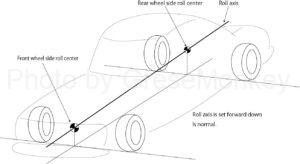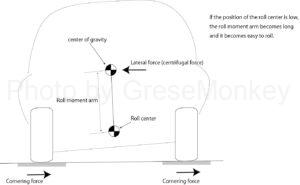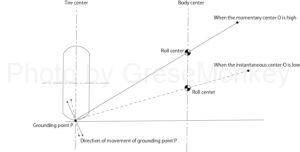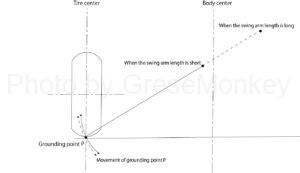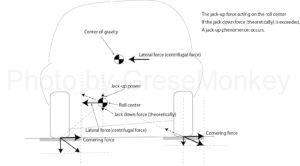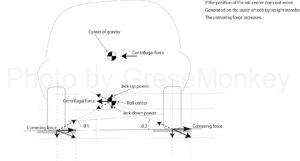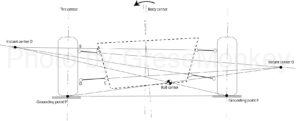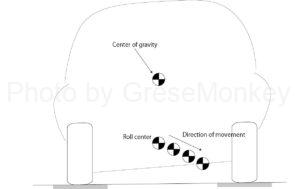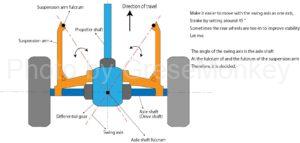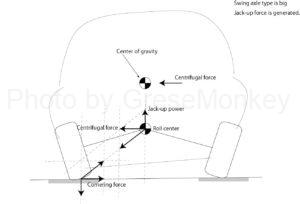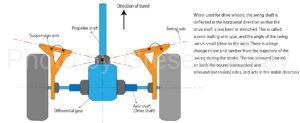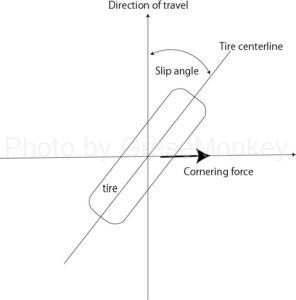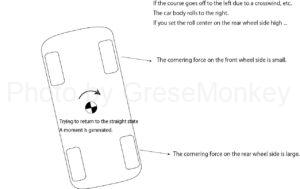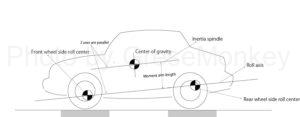Suspension and roll center
From the viewpoint of steering stability, it is desirable that the suspension does not stroke as much as possible. In the case of double wishbone suspension system, various measures can be taken to reduce the adverse effects of such suspension strokes.
Also, when the suspension strokes, the inclination and position of the tire are determined by the suspension geometry, but when considering this suspension geometry, it is important to consider the roll center. Is.
Here, we will consider the desired roll center.
table of contents
- About roll center
- Rolling moment
- Jack-up phenomenon
- Swing axle type jack-up phenomenon
- Is it desirable to have a low roll center?
- Inertia spindle
About roll center
The roll center is the center of movement when the vehicle body rolls due to cornering or the like. Actually, since the roll center is on both the front wheel side and the rear wheel side, the vehicle body rolls around this roll axis with the straight line connecting the roll center on the front wheel side and the roll center on the rear wheel side as the roll axis. I think that (refer graph1)
About roll center
Forces such as centrifugal force acting on each part of the vehicle body at corners are considered to act on the center of gravity as a representative. Then, the force for rolling the vehicle body is generated by the difference in height between the roll center, which is the center of instantaneous rotation when rolling, and the center of gravity, which is the force of centrifugal force.
In other words, since the roll center is the center of movement when the vehicle body rolls, the higher the position of the roll center, the shorter the distance from the center of gravity of the vehicle body, and the force that tries to tilt the vehicle body (trying to rotate). Force), that is, the length of the moment arm (roll moment arm in FIG. 2) is shortened.
At this time, the shorter the length of the roll moment arm, the smaller the moment for tilting the vehicle body even if the same lateral force is received, and the more difficult the roll motion becomes. (See Figure 2)
The cornering force is the force (centripetal force) that causes the tire to move inward of the circle against the centrifugal force. That is, when the roll motion becomes large, the suspension also makes a large stroke, so that the posture (alignment) of the wheels with respect to the road surface may change, which may adversely affect the steering stability. Therefore, the roll should be as small as possible. Therefore, it is ideal to keep the cornering force as small as possible.
Considering only the roll movement, it is desirable that the roll center is high.
However, simply raising the roll center generally increases the lateral movement of the tire contact point P. (See Figure 3)
When the lateral movement, that is, the tread change becomes large, the vehicle body is shaken by the unevenness of the road surface, and the vehicle body is shaken by the unevenness of the road surface, which causes wobbling. Therefore, in F1 and racing cars, there are many cases where the roll center is lowered to near the road surface in order to improve the performance of the tire and make it thicker and to reduce the large lateral force generated by a slight tread change. .. The reason why the vehicle height is lowered is also to lower the position of this roll center.
Jack-up phenomenon
The higher the roll center, the greater the force that tries to lift the vehicle body when it receives a lateral force such as centrifugal force. That is, the jack-up phenomenon will occur. (See Figure 4)
At this time, even if the position of the roll center cannot be moved when the vehicle body rolls in cornering, that is, θ1 and θ2 of the angle formed by the straight line connecting the roll center and the ground contact point of the tire in FIG. 5 with the road surface. Even if they are the same, the load on the outer wheels is increased by the load transfer due to the centrifugal force, so the cornering force generated is also large.
Therefore, the jack-up phenomenon occurs when the force generated by the outer wheels to lift the vehicle body becomes larger than the force generated by the inner wheels to pull down the vehicle body. The roll center here is considered as a point where the vehicle body receives the cornering force generated by the tires.
Generally, when the car body rolls, the roll center moves. (See Figure 6)
Therefore, if the suspension geometry is such that when the car body rolls, the roll center moves toward the contact patch of the tire inside the corner, the force to pull down the car body increases, and the car body moves at the corner. It is possible to perform cornering with a sense of stability that makes you feel like you are sinking. (See Figure 7)
On the contrary, if the suspension geometry is such that the roll center becomes higher toward the outside of the corner when rolled, the vehicle body is lifted, the jack-up phenomenon becomes large, and the behavior becomes unstable. (See Figure 8)
Swing axle type jack-up phenomenon
The swing axle type roll center is located slightly above the center of the differential. When the roll center is in a high position, the distance from the center of gravity to the center of gravity is shortened, so that it becomes difficult to roll even if the same lateral force is applied.
However, since the vehicle body does not roll much even when cornering, if the speed is increased in that state, when the lateral G reaches a certain value, the grip force may be suddenly lost without much roll motion. This is because when the car body is lifted, the positive camber of the wheels (tires) becomes larger and the jack-up phenomenon becomes larger. The behavior changes in the limit range, such as leading to spin. (See Figure 9)
In response to these problems, some models were developed by changing the suspension type to a semi-trailing arm type.
Is it desirable to have a low roll center?
Regarding the roll shaft connecting the front wheel side and the rear wheel side of the roll center, in many cases, the roll center on the front wheel side is generally given a slightly lower front characteristic. This is because when the tire rolls, the contact point of the outer tire during cornering tries to move further outward, but at this time, the direction in which the tire is facing and the direction in which the tire actually travels deviate (slip). This is because a kind of cornering force is generated (in a state where an angle is attached). (See Figure 10)
If the position of the roll center on the rear wheel side is high, even if the course of the car is disturbed by some factor, for example, a crosswind, the cornering force generated on the rear wheel when rolling will be larger than on the front wheel side, so the center of gravity of the car body should be adjusted. At the center, a moment that tries to return the car to the straight-ahead state is generated, and there is a tendency that the car is pushed back to the straight-ahead state and stabilized. (See Figure 11)
Inertia spindle
In addition to setting the front wheel lower, the roll shaft is considered to be desirable to be parallel to the inertial spindle of the vehicle body. (See Figure 12)
The inertial spindle is an axis that passes through the center of gravity of the vehicle body and minimizes the moment of inertia. There are three types of axes, yawing, pitching, and rolling (rolling), which are movements centered on the center of gravity, which are the basis of the behavior of the car, and each of them is orthogonal to the center of gravity of the car body.
The roll axis in question here refers to the X axis in FIG. 12 (1), that is, the one in the front-rear direction of the vehicle body. The moment of inertia here represents the difficulty of turning around the rotating body and the difficulty of stopping. In this case, the inertial spindle is slightly lower than horizontal when the heavy engine is below the front part of the vehicle body.
Here, if the roll shaft deviates from the parallel state with the inertial spindle, the vehicle body moves in the yaw direction when it rolls, so that the behavior of the vehicle body changes.
In the FF method, it is difficult to roll the rear wheel side and it is easy to roll the front wheel side to prevent the load from being excessively transferred to the front wheel outside the corner.
By such a device, it is possible to suppress the decrease in the cornering force which is the total of the left and right sides of the front wheel side, and at the same time, improve the ground contact property of the front wheel inside the corner to improve the maneuverability and acceleration. This is because the cornering force is roughly proportional to the load, but the rate of increase tends to gradually slow down as the load increases.
In addition, the roll center on the front wheel side is lowered in order to suppress the movement of the load. This is because when the lateral G acts, the lateral G acts on the center of gravity in the portion above the roll axis, and the lateral G acts on the roll axis in the portion below the roll axis. In this case, the moment acting on the roll axis is proportional to the height of the roll center. Therefore, when the roll center is lowered, the roll moment on the front wheel side is relatively lowered, and the load transfer is also lowered.
Generally, the tread change caused by rolling occurs when the suspension is stroking, so it does not occur once the roll has settled at a certain angle.
From the above, it can be said that how to set the position of the roll center is more related to the delicate feeling of the car body at the cornering entrance than to the improvement of cornering performance.
Citation sources / references / websites
Some of the texts on this site are quoted from the following books, publications, and websites.
・ “Vehicle motion performance and chassis mechanism” by Takaaki Uno Grand Prix Publishing
・ “Suspension mechanism and running performance” by Manabu Kumano Grand Prix Publishing
